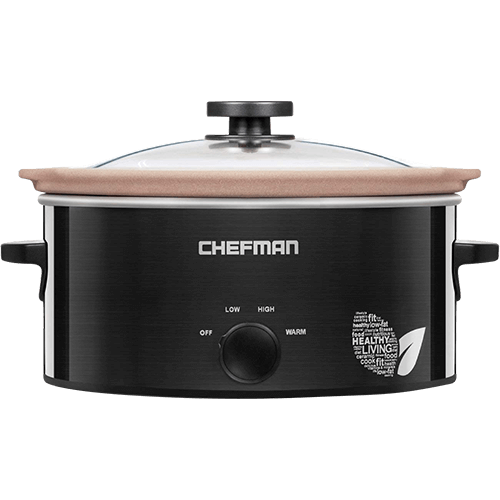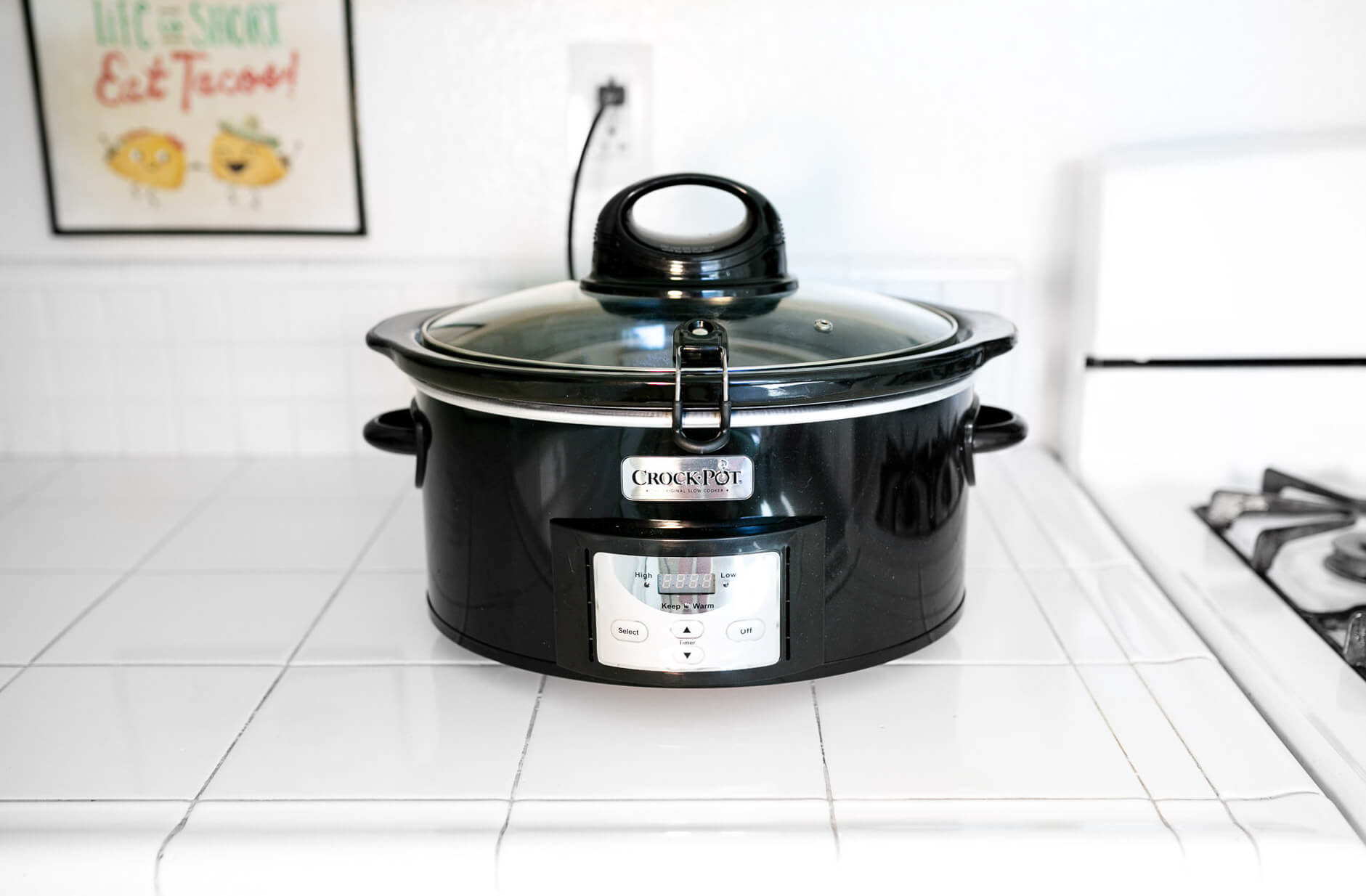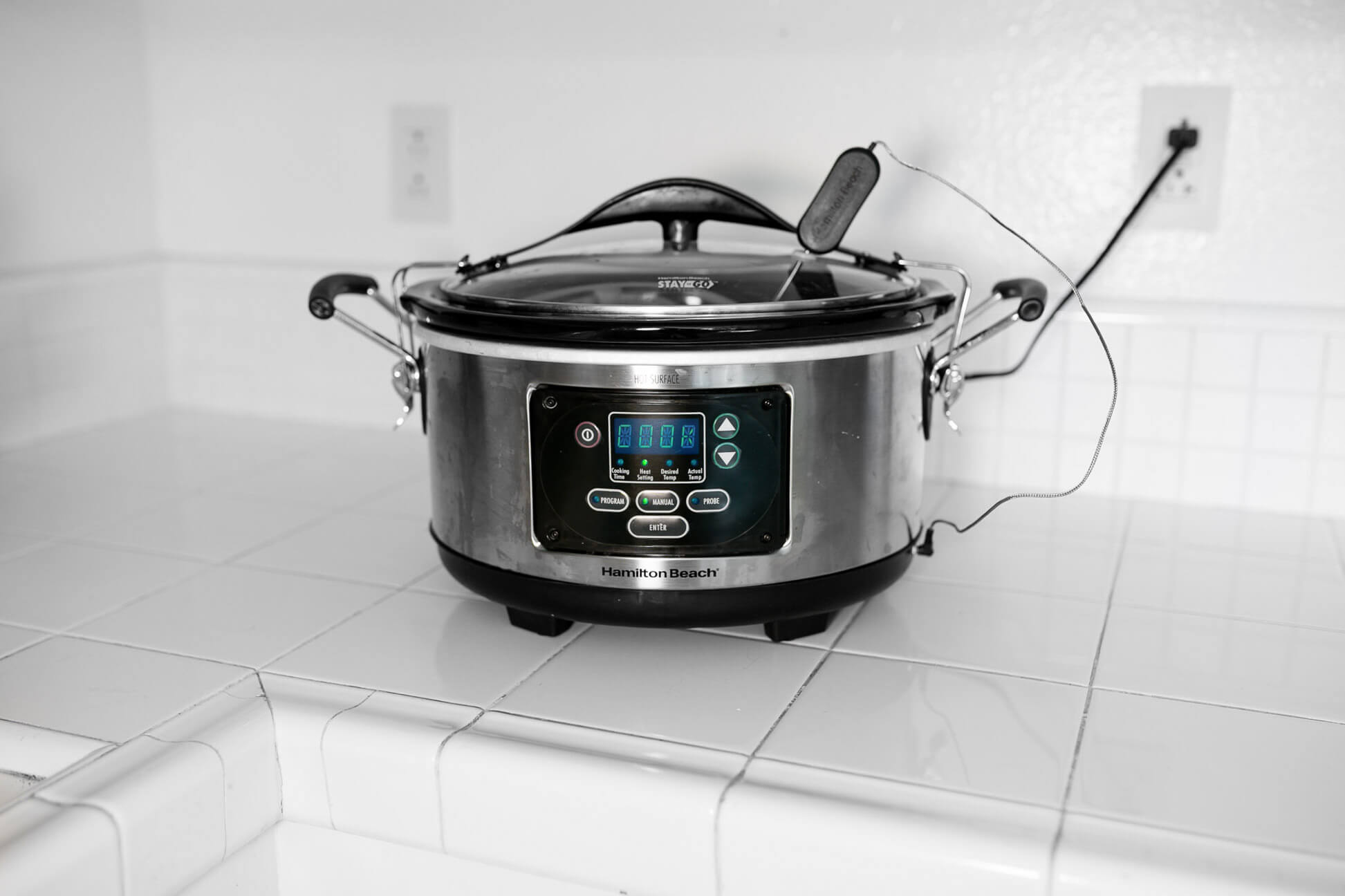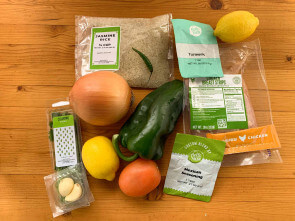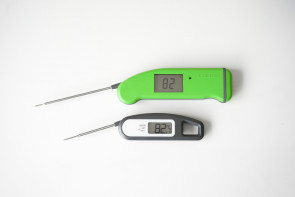
The Best Slow Cookers
We rigorously tested six popular slow cookers and after cooking 20 pounds of beef chuck roast and pots full of pinto beans, we found the Cuisinart – MSC-600 to be the best slow cooker overall. The Cuisinart handily outperformed the others we tested and its browning function made a substantial difference in both taste and texture of the pot roasts we cooked. At about half the price, the Chefman – RJ15-5-N is our runner-up.
We rigorously tested six popular slow cookers and after cooking 20 pounds of beef chuck roast and pots full of pinto beans, we found the Cuisinart – MSC-600 to be the best slow cooker overall. The Cuisinart handily outperformed the others we tested and its browning function made a substantial difference in both taste and texture of the pot roasts we cooked. At about half the price, the Chefman – RJ15-5-N is our runner-up.
Table of contents
- Slow cooker feature comparison
- Best overall: Cuisinart – MSC-600
- The runner-up: Chefman – RJ15-5-N
- Other finalists we tested
- How we selected products to test
- How we tested
- Important features to consider
- The bottom line
Slow cooker feature comparison
| Product | Price | Type | Cooking Performance | Capacity (Quarts) |
|---|---|---|---|---|
| 1. Cuisinart - MSC-600 | $$$ | Digital | 5/5 | 6 |
| 2. Chefman - RJ15-5-N | $$ | Manual | 5/5 | 5 |
| 3. Crock-Pot - SCCPVC600AS-B | $$ | Digital | 3/5 | 6 |
| 4. Proctor-Silex - 33042 | $$ | Manual | 3/5 | 4 |
| 5. Black+Decker - SC1007D | $ | Manual | 3/5 | 7 |
| 6. Hamilton Beach - 33969 | $$ | Digital | 2/5 | 6 |
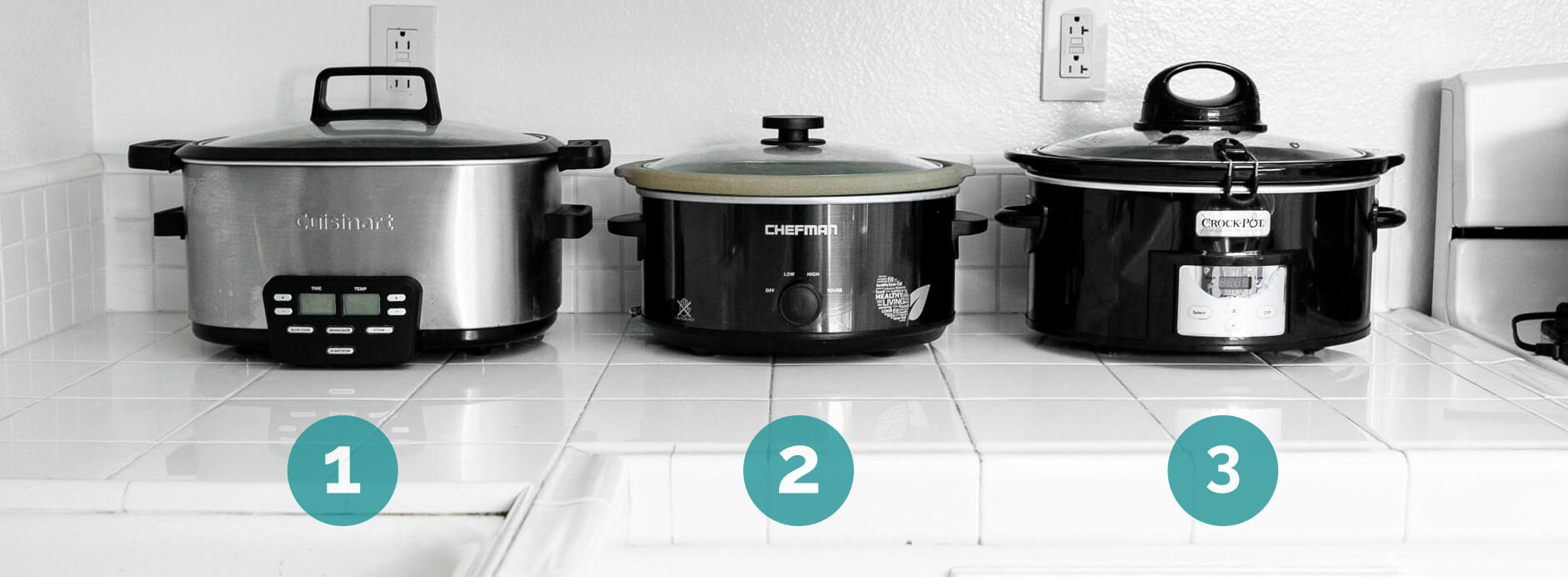
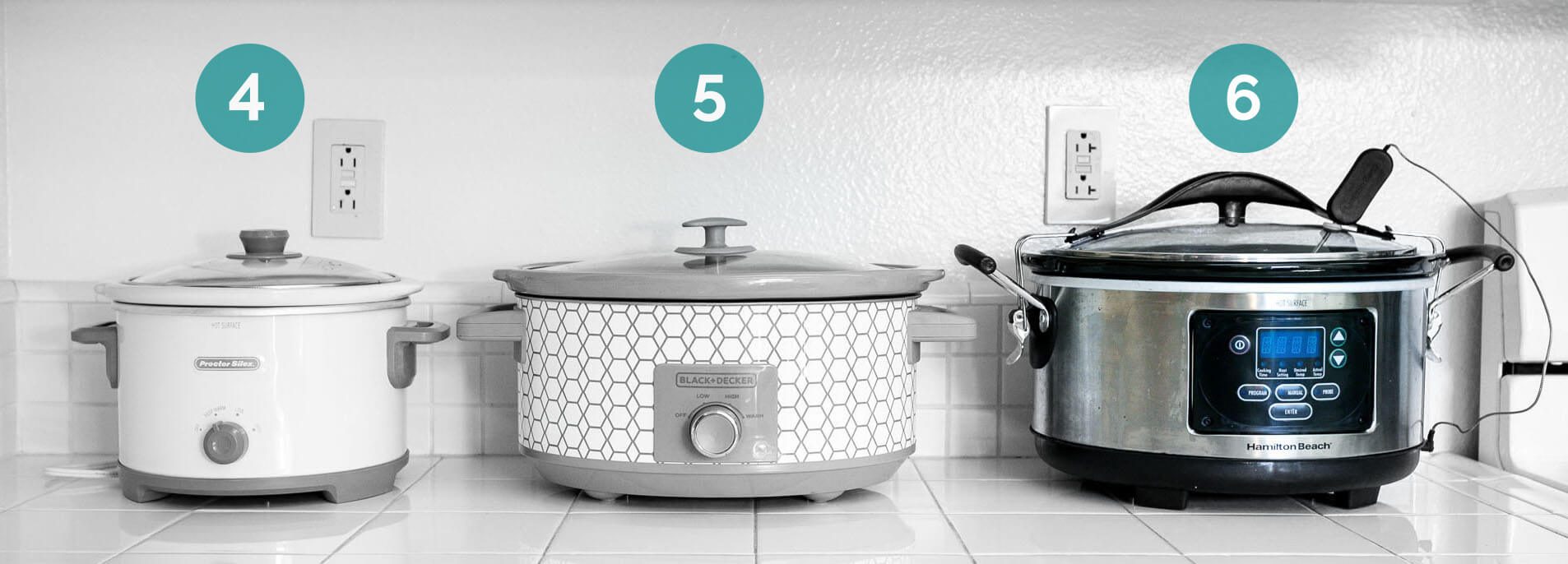
Best overall: Cuisinart – MSC-600
The Cuisinart – MSC-600 outperformed all of the slow cookers we tested. It maintained an ideal temperature range of between 199 ℉ and 210 ℉, which evenly cooked the beans at the low setting and produced a tender and juicy pot roast at the high setting.
Perhaps in an attempt to attract consumers not quite ready to dip into the Instant Pot pool, Cuisinart is marketing this 6-quart slow cooker as a three-in-one “multi-cooker,” which we believe is an overstatement. In reality, it’s a slow cooker with the additional functions of steaming and browning, both of which certainly elevate it above simpler models.
The Cuisinart has a brushed stainless-steel housing with a blue backlit LCD display and buttons for selecting slow cook, brown/saute, steam, start/stop and plus and minus increments for time and temperature. We found it very easy to program (without needing to consult the user’s manual) and can be adjusted at any point during the cooking time.
Its oval heating element is raised from the bottom of the housing unit and approximately runs the length and width of the inner pot. The inner pot is composed of sturdy but lightweight aluminum, which is coated with xylan, a nonstick coating manufactured by Whitford Worldwide. (There are concerns posted on Amazon that the coating is Teflon, long exposure to which is known to cause health issues. However, we confirmed with Cuisinart’s customer service that the inner pot is coated with xylan and not Teflon.)
The Cuisinart’s inner pot has BPA-free plastic cool-to-touch handles. It is the only inner pot of the slow cookers we tested that didn’t require us to use pot holders to remove it from the housing. The Cuisinart comes with a steaming rack and, like all slow cookers, a heavy glass lid. Our only criticism of the Cuisinart’s design is that the lid doesn’t lock onto the inner pot, so you need to devise a way to prevent spillage during transport. (One online suggestion is bungee cords.)
The Cuisinart maintained an optimal temperature range in all of our tests. For the beans (cooked at the low setting), once it reached 198 ℉, the temperature was sustained for three hours. The temperature in the center of the pot was minimally less by one or two degrees, a difference that did not affect the cooking. The beans were done after 5-½ hours, and they were all evenly cooked without any uncooked, hard beans mixed in.
The pot roast test was a real make-or-break for all of the slow cookers. The Cuisinart had the edge over the others, thanks to its excellent browning/sauteing function, which can be programmed up to 400 ℉, the hottest of all the slow cookers we tested.
Browning occurs at 280 ℉-330 ℉, so the Cuisinart can achieve similar results to those of a saute pan. Although many slow cooker recipes suggest that browning meat isn’t necessary, we found that it made a big difference in flavor.
The pot roast was done at four hours, and it was tender and beefy-tasting. We switched the temperature setting to warm, and because the Cuisinart’s warm setting is the lowest temperature (165 ℉) of all the slow cookers we tested, the roast did not dry out and stayed juicy an hour later.
The nonstick coated aluminum pot was easy to clean and is dishwasher-safe. We had a bit of trouble with cleaning stains from the heating element, and we noticed pinpricks of rust on the housing’s stainless steel after repeated use. It’s not a deal-breaker, but the stainless steel does need to be maintained.
The Cuisinart’s user manual and recipe booklet were by far the most complete and extensive, with recipes ranging from breakfast to entrees to sauces to desserts. (We did question, however, why anyone would want to wait 3 hours for oatmeal or breakfast strata to cook.)
The Cuisinart MSC-600 is a bit more expensive than the other slow cookers we tested, but for ease of use, performance and design, it is undeniably superior to the rest.
Key takeaways:
- The Cuisinart – MSC-600 has well-calibrated settings that quickly reach the programmed temperatures and sustain them throughout cooking.
- The Cuisinart is the only slow cooker we tested that had a browning/sauteing function, which adds substantial taste to slow-cooked meats, such as roasts and stews. It also saves time since you only have one pot to wash.
- Its non-Teflon-coated aluminum inner pot heats evenly without any hot spots and is easy to clean.
- The Cuisinart has an attractive stainless steel housing with an easy-to-read blue LCD display and simple programmable functions.
The runner-up: Chefman – RJ15-5-N
If you don’t mind giving up the Cuisinart’s digital programming feature, the manually-controlled Chefman – RJ15-5-N is a great option for about half the price. The Chefman has an attractive and unique stoneware crock with a nonstick, non-chemical (PFOA-free and PTFE-free) coating that is oven-safe — and the only inner pot of the slow cookers we tested that is stovetop-safe. The stoneware crock can be used for reheating food in the oven and for simmering or reducing sauces on a stovetop’s open flame.
In other respects, the Chefman is very similar to most slow cookers. It’s oval-shaped, has a tempered-glass lid and manually controlled settings for low, high and warm. The lid doesn’t have a locking device, so it can’t be readily transported elsewhere other than from the kitchen to the dining room table. The heating element is built within the stainless steel housing, so it gets very hot and can’t be touched without pot holders.
During our tests, the Chefman was a little slow at the low setting to reach the temperature above the danger zone, but at the high setting it hit 206 ℉ within 90 minutes and increased just a few degrees to 210 ℉, which it then sustained for three hours. The Chefman’s temperature range at high was comparable with the Cuisinart and kept the liquid at a steady simmer without ever boiling.
The pinto beans completed cooking in six hours, and although a few from the center of the pot were not as well-cooked as those around the edges of the pot, they were flavorful. The Chefman’s pot roast was on par with the Cuisinart’s — tender, juicy and beefy. Its warm setting was a little high at 206 ℉, but even at that temperature, the roast didn’t dry out.
The Chefman’s housing was easy to clean, and the stoneware crock and lid are dishwasher-safe. The pot roast left slight staining in the crock, but this can be cleaned with a paste of water and baking soda.
The Chefman is about the same price or even a bit less expensive than the other slow cookers we tested that didn’t perform nearly as well. So if you don’t mind having to manually control temperature and time, we can recommend the Chefman as an excellent alternative to the more high-end Cuisinart.
Key takeaways:
- The Chefman – RJ15-5-N is the only slow cooker we tested that can be used in the oven for reheating food and on a stovetop open flame for simmering and reducing sauces and gravies.
- Its attractive and unique chemical-free stoneware crock evenly distributes heat and maintains temperatures for its settings.
- The Chefman is well-priced for such a high-quality slow cooker.
Other finalists we tested
Crock-Pot – SCCPVC600AS-B
Another slow cooker that comes with bells and whistles is the Crock-Pot – SCCPVC600AS-B, a 6-quart slow cooker, and it’s also highly rated on Amazon. This Crock-Pot has simple digital programming with an easy-to-read LCD display that flashes between heat setting and remaining time to the program.
The Crock-Pot ran a bit cool overall, not exceeding 200 ℉ on the low setting and 206 ℉ on the high setting. The beans were done in five hours, but they were inconsistently cooked; some were soft, others were mealy. The pot roast took 5-½ hours, and although the bottom half of the roast was juicier, it was still tender and quite flavorful.
During our first tests, we experienced a couple of issues, so we decided to test a second unit to determine whether our first unit was faulty or not.
With the first unit we noticed a strong, acrid smell emitting from the Crock-Pot’s housing. There are some complaints from Amazon reviewers about this prevalent odor, and the Crock-Pot company claims that it will lessen over time. However, even after repeated washings, the first unit’s odor did not dissipate and added an unpleasant metallic flavor to the beans and pot roast.
We had better success with the second unit. We again smelled the distinctive odor during the water test, but it lessened after each subsequent use and did not affect the food.
The second issue we had was with the Crock-Pot’s automatic stirring attachment. It has its own power source, so the Crock-Pot itself is plugged into the stirring motor. It’s equipped with two paddles: a four-pronged metal paddle for stew and a wide plastic paddle for soup and chili.
The stirrer can be programmed to stir at 30-minute intervals. It’s a great idea, if only it worked. After the first unit failed to stir, we tested the second unit, and it also failed to stir at the programmed time. The stirrer has a “pulse” button, which lets you stir without using the program, and this worked fine both times.
Crock-Pot has other programmable models without the automatic stirring attachment, which might be more reliable for the same midrange price.
Proctor-Silex – 33042
This is a basic, round, no-frills 4-quart slow cooker. Its dishwasher-safe ceramic pot and glass lid fit into a metal housing with manual controls. As the housing heats up, it gets very hot and can’t be touched.
At the low setting, it took over two hours for the Proctor-Silex – 33042 to surpass the 140 ℉ danger zone, and then it didn’t reach a temperature at which food would actually cook until four hours later. One can imagine coming home to a stew after a day at work and finding it half raw.
The beans and pot roast test results were wildly divergent. It took the Proctor-Silex 11-½ hours to cook the beans through.
However, the pot roast surprised us by being one of the best we cooked. It took a bit longer at the Proctor-Silex’s high setting — six hours — but it shredded easily and had lots of meaty flavor.
One advantage to the Proctor-Silex’s cooler temperature is that the keep-warm setting is 189 ℉, which was enough to keep the roast hot, but not overcook it.
The Proctor-Silex is a bit more expensive than our runner-up, the Chefman. It’s not a bad little slow cooker at its high setting, but it’s too-low temperature doubles the cooking time of recipes that need a low setting, such as soups and stews.
Black+Decker – SC1007D
The Black+Decker – SC1007D is an oval, 7-quart slow cooker with a stoneware inner pot that fits into a metal housing with models that are decorated with three different retro designs. The housing’s plastic handles are cool-to-the-touch, although, like other slower cookers, the inner pot’s handles cannot be touched without pot holders. The Black+Decker also has the same basic, manual settings of low, high and warm.
The tempered glass lid is not secured, and throughout cooking, as the liquid boiled, the lid rocked up and down, leaking built-up condensation into the lip of the stoneware pot and into the food. After we finished testing, we noticed that this condensation had dripped down into the housing unit and stained the heating element.
The Black+Decker runs very hot (209 ℉-212 ℉), which caused rapid evaporation of the cooking liquid, so we needed to add more liquid to prevent the beans from drying out. The beans were done in six hours, with beans in the center much harder than those along the edges of the inner pot. These results indicate that you would need to occasionally stir anything you’re cooking to ensure it all cooks the same.
The high heat cooked the pot roast in 4-½ hours, but because it maintained the temperature at the boiling point for two hours, the beef was bone dry.
The Black+Decker is about five dollars less than the Chefman, but it’s certainly not worth the small savings.
Hamilton Beach – 33969 Set ‘n Forget
The Hamilton Beach – 33969 Set ‘n Forget shows up on a lot of “the best of” lists, but we were less impressed, particularly with its digital programming, which we found to be difficult to use.
Settings are programmed by pushing a series of buttons, and once the program begins, it can’t be changed. So if the temperature is too high or too low, or if you want to adjust the time, you need to cancel the program altogether and reprogram the new settings.
The Hamilton Beach has a couple of excellent features. A rubber gasket lines the inside of the glass lid, which keeps the lid snugly secured during cooking. The lid has two vent holes to prevent condensation forming. The Hamilton Beach is also transportable without leaks, thanks to two clips on either side of the lid that snap onto hooks on either end of the pot.
Its unique feature is a meat probe, which can be programmed to automatically switch the cooker off when the meat reaches the designated internal temperature. This feature works for a large roast and a whole chicken; however, the probe simply isn’t long enough to get into the center of a smaller piece of meat. So it’s a nice feature, but unless Hamilton Beach extends the length of the probe, it’s pretty useless.
The Hamilton Beach also runs too hot on both high and low settings. After six hours, the beans were soft around the edges of the inner pot and only half-cooked in the center of the pot. Those beans that were fully cooked tasted delicious. The high setting boiled the pot roast for nearly three hours, resulting in dry, stringy beef.
The Hamilton Beach is about $50, approximately half the price of our top pick, the Cuisinart, and although it might make an attractive addition to your countertop, it just doesn’t perform as well.
How we selected products to test
In the 1970s you could pretty much count on finding a slow cooker in every kitchen. The slow-cooker revolution let working parents cook a full meal all day unattended without worrying about the house burning down. With the recent advent of electric pressure cookers (for example, Instant Pot), you might think that slow cookers are less popular. But defying the odds, sales of slow cookers have actually increased substantially, thanks in part to a global market.
Factors contributing to sales growth are portability, programmable functions and low power consumption. Based on our research of consumer posts on reddit, Consumer Report’s buying guide and Amazon, as well as information gleaned from other review sites, we chose to test a wide range of newer models with add-on features and less-expensive models with basic functions.
How we tested
Temperature

Depending on the recipe and what you’re cooking, a slow cooker needs to rapidly reach and exceed 140 ℉ — the “danger zone” where salmonella bacteria can grow — and continue to increase in temperature to no higher than 210 ℉ for a period of four-to-eight hours. If the temperature exceeds 210 ℉ and hits the boiling point at 212 ℉, the food will cook too quickly and dry out.
On the keep-warm setting, the slow cooker must also sustain a temperature not lower than the “danger zone,” below 140 ℉, to inhibit bacterial growth.
To ensure food safety, modern slow cookers are much hotter than the 1970s slow cookers, so anything you cook in a slow cooker can easily overcook. It’s a good idea to actually take your slow cooker’s temperature to know whether you need to change a recipe’s timing.
We filled all of our slow cookers halfway and set them on low. Over the next four hours, we used an instant-read thermometer to check temperatures every hour. Some slow cookers have hot spots around the edges of the inner pot, closest to the heating element, and these hot spots will cook food faster than the food in the center of the inner pot.
The Cuisinart – MSC-600 was the only slow cooker that hit above the danger zone in the first hour. By 90 minutes, all of the slow cookers — except the Proctor-Silex – 33042 — were between 147 ℉ – 152 ℉. The Proctor-Silex didn’t clear the danger zone until after the second hour. At this point, the internal temperature of a large piece of beef or a whole chicken would not have reached above 140 ℉, so there would be a risk of bacterial growth.
By the third hour, all of the slow cookers’ temperatures had spiked 20 degrees. By the fourth hour, all — except for the Cuisinart — increased by another 10 degrees. The Cuisinart stayed consistent at 199 ℉, a good temperature for the low setting.
For our final water test, we turned up the setting to high. Within 30 minutes, all of the slow cookers hit over 200 ℉ with the Black+Decker – SC1007D at boiling (212 ℉), which is much too hot. The Cuisinart reached its high temperature at 209 ℉ and sustained it for the next hour.
Performance

For our performance tests, we selected pinto beans and pot roast because they ran the gamut of different preparation, heat levels and cooking times. Many online recipes suggest heating up the slow cooker at high for one hour and then adjusting it to the low setting for the remainder of the cooking time. However, we decided it would be a fairer test of performance to cook at its low and high settings without making any adjustments to temperature.
We soaked one pound of pinto beans per slow cooker overnight, drained them and combined the beans with enough water to cover them by two inches. Each slow cooker was set at low, and we took the temperature at the center and the edges of the inner pot every hour. At the third hour of cooking, we began to test the beans for level of doneness.
We intentionally didn’t stir the beans so we could determine whether the beans in the center of the pot cooked differently than those around the edges of the pot. (Under normal non-test conditions, the beans should be stirred.)
Slow cookers have always been marketed as a “set-it-and-forget-it” appliance. Theoretically, you could layer meat and vegetables in the slow cooker, set it on low and leave it unattended for eight hours. However, our results showed that unless you occasionally stirred or checked on what you’re cooking, you would wind up with chewy, undercooked or overcooked food.
For the pot roast test, we cut three-pound pieces of beef chuck, approximately two inches thick, from the same large piece of beef. We seasoned each three-pound roast with Kosher salt and black pepper and added enough beef broth to fill each slow cooker halfway. We set the slow cookers on high and recorded the temperatures of the liquid at one-hour intervals. Once the roasts were done (approximately 4-½ to 5 hours), we adjusted the setting to warm for an additional hour to test how the cooked roasts might be affected.
Important features to consider

Capacity: Slow cookers come in a number of sizes, ranging from a capacity of 1.5 quarts to 8 quarts. The user manuals of the slow cookers we tested advise filling the slow cooker to a maximum of three-quarters full, so capacity is important for what you plan to cook and for how many people. Most manufacturers recommend a 5- or 6-quart model for a family of four, and it can easily accommodate a whole chicken, beef roast or pork shoulder for pulled pork. If you plan to cook chili, soup or stew for a crowd or in bulk quantities for freezing, then the 7- or 8-quart model would be best.
Removable inner pot: Slow cooker inner pots are round, oval or oblong, and most are ceramic or stoneware. If you want to make desserts in a slow cooker, a circular cake pan or springform pan can fit into a round inner pot. However, for chili, soups and stews, we found that the heat was better distributed in the oval or oblong inner pot and required less stirring.
Sealing/locking lid: A glass lid that seals with a rubber gasket and locks onto the slow cooker maintains a consistent internal temperature in the inner pot. A sealing/locking lid is also essential for transporting the inner pot without spillage.
Programmable controls: Newer models have digital controls, which can be programmed to schedule time and temperature settings. The programmable models are especially convenient for all-day cooking, automatically switching from the cook mode to the keep-warm mode and preventing overcooking.
“On” light: Surprisingly, very few slow cookers have an “on” light. None of the manual models we tested had an “on” light, so we didn’t know if the slow cooker was functioning unless we touched the sides of the slow cooker’s housing. Some digital models have an “on” light or a “ready” light to indicate that the inner pot has reached the programmed temperature.
Browning/sauteing function: The majority of slow cooker inner pots are oven-safe, but they aren’t stovetop-safe, so meat and vegetables should be browned or sauted in a separate pan. A browning function isn’t essential, but it does give you the ability to brown a roast without washing a second pan.
Why buy a slow cooker?
Since the 1970s, when the Crock-Pot was introduced, the slow cooker has been a must-have kitchen appliance. It’s particularly helpful for working parents who don’t have time during the workweek to fix a meal for the family.
Today there’s a broad range of slow cookers you can buy. The simpler models haven’t changed much since the 1970s, but newer models are programmable and can also be Bluetooth capable. Fancy or simple, they all share the same desirable characteristics that make the slow cooker one of the most purchased kitchen appliances in the world.
Convenience: This is the number one reason why people buy a slow cooker. The ingredients for a recipe can be layered in the stoneware or ceramic pot (and refrigerated) the night before or in the morning. Plug it in, set it on low and eight hours later, you’ve got a luscious beef pot roast or whole chicken and vegetables ready to serve.
Low power consumption: The slow cooker is undoubtedly a cost-efficient way to cook. On average, the slow cookers we tested ranged between 180 watts and 320 watts. (The Cuisinart is the highest at 1,350 watts.) In comparison, an electric oven can use a significantly higher 2400 watts. Using this calculator to calculate energy consumption at 10 cents per kilowatt hour, an electric oven used for a four-hour period could cost approximately $1 per day. A slow cooker (using the average wattage of the models we tested) at 250 watts for eight hours would cost only 19 cents per day. Even the higher wattage Cuisinart consumes half the energy of an electric oven.
Portability: A slow cooker is ideal for a holiday meal, a family get-together, potlucks and even a tailgating party, since you can cook the food in one location and transport it, still warm, to another location. A slow cooker is also approved by Jewish religious leaders for partially cooking, warming and serving the traditional cholent stew during the Sabbath (when all cooking is forbidden).
Economy: Most slow cookers are inexpensive and as noted above are cheap to operate. But a slow cooker could also reduce your grocery bill since you can buy less-choice, tough cuts of meats, which the slow cooker simmers to incredible tenderness.
The bottom line
The slow cooker has come a long way since the 70s, but some companies haven’t changed their model very much since then. We think that with all of the technology available, it makes sense to buy a digital slow cooker that ensures a constant temperature, is easy to program and gives consistent cooking results.
Three of the six slow cookers that we tested were digital, and the Cuisinart – MSC-600 was undoubtedly the best. Its unique additional feature of a browning/sauteing function is a real bonus for adding rich flavor to roasts and stews. The Cuisinart does not get too hot — an issue with almost all slow cookers — and it maintains the programmed temperature for hours at a time. It’s a bit more expensive, but we feel the Cuisinart is worth it.
Of the three manually controlled slow cookers, we preferred the Chefman – RJ15-5-N to the others. Its nonstick, chemical-free stoneware crock is both oven-safe and stovetop-safe, and it maintained temperature settings like the Cuisinart. At half the price, if you don’t mind losing the digital programming, the Chefman is a worthy pick.
Slow Cooker Recipes

We couldn’t spend hours of testing slow cookers without making our food and cooking expert’s favorite family-style recipes. After years of hosting barbeques and family get-togethers, our team cooked up 10 of the easiest and tastiest recipes to help you plan your Labor Day celebration.
From baked beans with a twist (hint: bacon), to garlic Parmesan potatoes that your guests are guaranteed to polish off, you can easily whip up a spread without the major time commitment. And the best part? Clean up is a breeze with recipes made in a slow cooker.
To make planning easier, we created printable recipe cards to follow on the day of your bash. Print them out, and if one of our dishes becomes a staple, save the recipe card for a future celebration!
Lil’ Garlic Parmesan Potatoes
Baked, boiled, fried and grilled, there’s no denying that people love potatoes in all forms. Surprise your guests with a delicious, yet easy-to-make batch of garlic Parmesan potatoes to serve alongside your Labor Day spread.

Creamy Homemade Mac and Cheese
Nothing says comfort food like a creamy batch of homemade mac and cheese. This recipe will pair well with barbeque chicken and corn bread in your Labor Day spread, but don’t be surprised if this dish becomes a staple in your family. Feel free to add any of your favorite cheese to the recipe to make it your own!

Hearty Sausage and Pepper Hoagies
A comforting, flavorful meal doesn’t have to take hours of prep. Our hearty sausage and pepper hoagie recipe requires five simple, and inexpensive ingredients that will leave your guests feeling full. If you have a guest who exclusively eats gluten-free food, provide an option to serve over rice.

Sweet Slow-Cooked Green Beans
Throw a green side into the mix with slowly cooked green beans. The added onion and thyme will bring the staple side dish to the next level — just don’t be surprised if you get requests for the recipe.

Creamy Queso Dip
Whether you’re looking for an appetizer to serve while barbequing, or want to add a homemade dip to the spread, our creamy queso dip has you covered. Make it your own by adding your favorite salsa, from mild to extra hot (but make sure to warn your guests!).

Herb Roasted Vegetables
Add color to your spread with some classic vegetables packed with flavor. If you have extra hands in the kitchen, this is the perfect dish to delegate as you prepare your more complex dishes.

Lemon, Rosemary and Garlic Chicken
Minimal ingredients doesn’t mean minimal flavor. Our slowly cooked lemon, rosemary and garlic recipe will have your company requesting seconds. Customize your dish with the flavors you like best — most combination of herbs will only elevate the taste.

Smoky Bacon Baked Beans
Did someone say bacon? Baked beans are a staple of almost every barbeque, but you can bring the staple dish to the next level with some mouth-watering, crispy bacon. Plus, who wouldn’t love the smell of bacon filling the kitchen?

Old Fashioned Peach Cobbler
Nothing says sweet summertime than topping off a barbeque with an old fashioned peach cobbler. Surprise your guests with the warm treat topped with a scoop of vanilla bean ice cream! Take it to the next level by making your own creamy ice cream using a personal ice cream maker.

Finger-Lickin’ Pulled BBQ Chicken
A barbeque isn’t complete without a savory sandwich in the mix. But if you have a large group, it can be time-consuming to cook up dozens of chicken breasts and host at the same time. Instead, our pulled BBQ chicken recipe takes only a few minutes to prep, and you can have it ready before guests even arrive. Serve it with coleslaw, a warm bun and voila — you have a satisfying staple that your guests will love.

No Labor Day is complete without a few barbeque staples. These recipes are so simple that you can even get your kids involved — cut up the ingredients and have them mix them into the crockpot. They’ll love to be your little helper for your celebration. Consider making a recipe book with our recipe card printables by clicking the download all recipes button below and printing them out. Then, use a hole punch to create holes in the corner of each card and tie them together with a ribbon or twine.
More Reviews
The 8 Best Electric Egg Cookers
Elite Gourmet - EGC-007B
The 8 Best Salt and Pepper Grinders
Merazi Living
Blue Apron
Martha & Marley Spoon
HelloFresh Meal Delivery Kit Review
HelloFresh
Mueller - MFFVS-01
Lékué - Microwave Popcorn Popper



